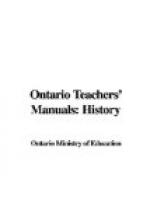6. This stage began with the invention of iron-smelting. Immense progress was now possible in the various arts of peace: house-building, road-making, construction of vehicles, the making of all sorts of tools. By these tools man was now able to express his aesthetic nature as never before. Implements of war also became more numerous and more deadly.
7. The human race was now lifted from the highest stage of barbarism to the lowest stage of civilization by one of the most important inventions that man has ever made—writing. This made possible the recording of man’s deeds and thoughts for posterity, thus securing the gains of each generation for all succeeding generations, and making history possible.
8. The next stage of progress is marked by a group of inventions,—gunpowder, the mariner’s compass, and paper and the printing press. The Middle Ages, as we call them, were now ended, and the human race found itself on a stage as wide as the world.
9. The next invention, which came quickly after the preceding ones, and placed mankind in the present stage of civilization, was the steam-engine. The revolution which this brought about is so recent as to need no details here. (See lesson on the Industrial Revolution, p. 87.) What is to be the invention that will mark the entrance of the race on a higher stage still, when Tennyson’s dream of a “Federation of the World the Parliament of Man” may be realized? Is it the airship, giving man the conquest of the last element still unmastered?
THE NEW LEARNING
1. The aim of this lesson is to make the pupils familiar with one of the most important movements in English history, by having them study the meaning, causes, tendencies, and effects of the New Learning.
2. As an introduction, a lesson or two should be given on the conditions prevailing in Europe during the latter part of the Middle Ages, because a knowledge of these conditions is essential to a right understanding of many of the causes of the New Learning.
The New Learning was a phase of a greater movement called the Renaissance, which arose in Italy during the fourteenth century. The Renaissance marked the end of the Middle Ages and the beginning of modern history. It meant re-birth, a new life. People took a new interest in living. The influence of the monk and of the knight was passing, and the man of affairs, with his broader sympathies, his keener vision, his more varied interests, and his love of liberty, was coming into prominence.
How to enjoy life, how to get the greatest value out of it, became the great problem. In their attempt to solve this problem people turned their attention to the ancient literature of Greece and Rome; for it was believed that the ancient Greeks and Romans had a fine appreciation of the meaning and beauty of life. They began to seek out the old literature and to study it. This new study has been called the Revival of Learning or the New Learning. The influence of these two great literatures soon made itself felt. Every province of knowledge was investigated, and people everywhere were influenced by this great intellectual awakening.




